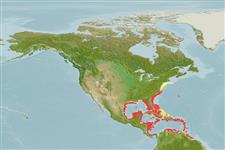>
Perciformes/Scorpaenoidei (Scorpionfishes) >
Scorpaenidae (Scorpionfishes or rockfishes) > Scorpaeninae
Etymology: Scorpaena: Latin, scorpaena = a kind of fish, 1706 (Ref. 45335).
Eponymy: Dr Frederico Guillermo ‘Carlos’ (Friedrich Wilhelm Carl) Berg (1843–1902) was a Latvian entomologist and naturalist. [...] (Ref. 128868), visit book page.
More on authors: Evermann & Marsh.
Environment: milieu / climate zone / depth range / distribution range
Écologie
marin récifal; profondeur 1 - 75 m (Ref. 7251). Subtropical; 41°N - 7°N
Western Atlantic: Bermuda, New York to Florida (USA), Bahamas, and Mexico to northern South America.
Taille / Poids / Âge
Maturity: Lm ? range ? - ? cm
Max length : 10.0 cm TL mâle / non sexé; (Ref. 7251)
Inhabits shallow clear waters from shore to 75 m depth.
Life cycle and mating behavior
Maturité | Reproduction | Frai | Œufs | Fécondité | Larves
Robins, C.R. and G.C. Ray, 1986. A field guide to Atlantic coast fishes of North America. Houghton Mifflin Company, Boston, U.S.A. 354 p. (Ref. 7251)
Statut dans la liste rouge de l'IUCN (Ref. 130435: Version 2024-2)
Menace pour l'homme
Harmless
Utilisations par l'homme
Outils
Articles particuliers
Télécharger en XML
Sources Internet
Estimates based on models
Preferred temperature (Ref.
123201): 23.2 - 28, mean 25.7 °C (based on 308 cells).
Phylogenetic diversity index (Ref.
82804): PD
50 = 0.5000 [Uniqueness, from 0.5 = low to 2.0 = high].
Bayesian length-weight: a=0.01738 (0.01030 - 0.02933), b=3.13 (2.99 - 3.27), in cm total length, based on LWR estimates for this species & Genus-body shape (Ref.
93245).
Niveau trophique (Ref.
69278): 3.4 ±0.2 se; based on size and trophs of closest relatives
Résilience (Ref.
120179): Haut, temps minimum de doublement de population inférieur à 15 mois (Preliminary K or Fecundity.).
Fishing Vulnerability (Ref.
59153): Low vulnerability (10 of 100).
